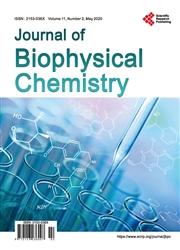A conformational B-Z DNA study monitored with phosphatemethylated DNA as a model for epigenetic dynamics focused on 5-(hydroxy)methylcytosine
引用次数: 8
Abstract
This study was directed on the B- into Z-DNA isomerization with alternating CG sequences monitored with artificial DNA model-systems based on methylation of the phosphate backbone. The chemical concept for this transition wherein shielding of the oxygen anions of the backbone phosphates plays an essential role, resulted in the preparation of the phosphatemethylated d(CpG). Even on this primitive level of only two base pair long, the B-Z conformational aspects of this self-complementary duplex could be described in solution with nuclear magnetic resonance (NMR) and circular dichroism (CD) measurements. The exclusivity of this choice became clear after synthesizing phosphatemethylated DNA with longer alternating CG fragments. It could be shown that conflicting conformational effects of the CG and GC fragments resulted in an overall B structure of the phosphatemethylated tetramer d(CPGPCPG). From our model considerations, it is clear that the internal stress introduced by the alternating CG sequences will be promoted by a complete shielding of the phosphate backbone. Elimination of this effect may be realized by a site-specific phosphate shielding. The role of the anti-syn isomerization of G in the CG fragments is clarified by methylation of the phosphate group. This anti-syn transition is absent in corresponding methylphosphonates, suggesting an exclusive role for base-backbone coordination via hydrogen bonding. In addition, we propose that the B- into Z-DNA interconversion may offer a mechanistic view for differences in dynamics between cytosine and its epigenetic derivative 5-methylcytosine. This mechanism has been extended to the demethylation of 5-methylcytosine and the exchange of information between the new epigenetic base, 5-hydroxymethylcytosine and the DNA backbone via an intramolecular phosphorylation. The role of 5-hydroxymethylcytosine in Alzheimer disease has been briefly discussed. In our opinion, this study can be considered as a new dynamic concept for epigenetics based on the dynamics of the B-Z transition in natural and phosphatemethylated DNA.一项构象B-Z DNA研究以磷酸甲基化DNA作为表观遗传动力学模型,重点关注5-(羟基)甲基胞嘧啶
本研究是在基于磷酸主链甲基化的人工DNA模型系统监测交替CG序列的B-到Z-DNA异构化。这种转变的化学概念,其中屏蔽主磷酸盐的氧阴离子起着至关重要的作用,导致磷酸甲基化d(CpG)的制备。即使在只有两个碱基对长的原始水平上,这种自互补双相的B-Z构象方面也可以用核磁共振(NMR)和圆二色性(CD)测量在溶液中描述。这种选择的排他性在合成具有较长交替CG片段的磷酸甲基化DNA后变得清晰。可以证明,CG和GC片段的相互冲突的构象效应导致磷酸甲基化四聚体d(CPGPCPG)的整体结构为B。从我们的模型考虑,很明显,由交替的CG序列引入的内应力将被磷酸盐主链的完全屏蔽所促进。消除这种影响可以通过特定位点的磷酸盐屏蔽来实现。G在CG片段中的反syn异构化作用通过磷酸基的甲基化来阐明。在相应的甲基膦酸盐中不存在这种反syn转变,这表明通过氢键进行碱基-骨干配位的唯一作用。此外,我们提出B-到Z-DNA的相互转换可能为胞嘧啶及其表观遗传衍生物5-甲基胞嘧啶之间的动力学差异提供了机制观点。这一机制已经扩展到5-甲基胞嘧啶的去甲基化,以及通过分子内磷酸化在新的表观遗传碱基、5-羟甲基胞嘧啶和DNA主链之间进行信息交换。本文简要讨论了5-羟甲基胞嘧啶在阿尔茨海默病中的作用。我们认为,这项研究可以被认为是基于天然DNA和磷酸甲基化DNA的B-Z转换动力学的表观遗传学的一个新的动力学概念。
本文章由计算机程序翻译,如有差异,请以英文原文为准。
求助全文
约1分钟内获得全文
求助全文

 求助内容:
求助内容: 应助结果提醒方式:
应助结果提醒方式:


